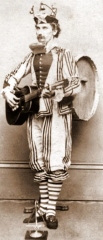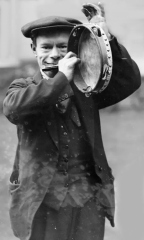England: Over one century of the panpipes and tabor
19th century
Pandean pipes or mouth organ ?
The majority are extracts from larger pictures and prints. Links to originals are given, where possible. If you have any more information on any of these images, or you are the copyright holder and I have not managed to get in touch with you, please do let me know.
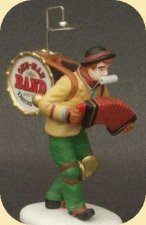
| The mouth organ, also known as the harmonica developed in the early 19th century. "There is documentary evidence that harmonicas were being sold in Vienna in 1825..." | ||
| Although there are now many different styles of mouth-organ they are all based upon a set of reeds which are pre-tuned to individual tones. Longer reeds make deep, low sounds and short reeds make the higher-pitched sounds. | ||
| In Germany in 1821 sixteen-year-old Christian Friedrich Buschmann (1805-1864) registered patents for a musical invention that various other people were also making and modifying, called an aura. The name 'Aura' was used in German to mean a Jew's Harp, a very old and popular folk instrument. Buschmann's aura was a free-reed instrument consisting of a series of steel reeds arranged together horizontally in small channels. Whether he actually invented the mouth-organ instrument is not clear and so these days this is thought to be only a persistent legend that cannot be substantiated. | ||
| Buschmann described his new instrument to his brother as: "a new instrument that is truly remarkable. In its entirety it measures but four inches in diameter...but gives me twenty-one notes, and all the pianissimos and crescendos one could want without a keyboard, harmonies of six tones, and the ability to hold a note as long as one would wish to”. | ||
The actual history of the mouth-organ was never been fully written down at the time and is now lost. A Bohemian instrument maker named Richter around 1826 may have developed a variation that consisted separate blow and draw reed plates utilizing a diatonic scale. Another German, Christian Messner in his clock making firm in Trossingen in 1827 began manufacturing instruments that were similar to Buschmann's 'aura' which he called mundaeolines. | ||
In 1857 German clock maker Matthias Hohner turned to manufacturing harmonicas full-time. In the first year he produced 650 instruments. After that he developed mass production techniques so that by 30 years later Hohner was producing more than one million harmonicas annually. By the 1920's sales had grown to 2.5 million instruments a year.
| ||
1812 Police Report, London 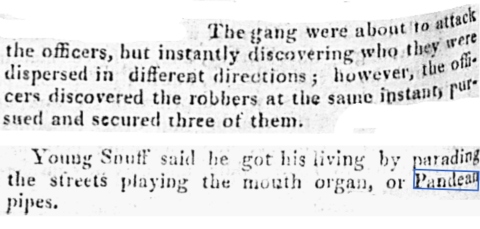 Saint James's Chronicle - Saturday 14 November 1812 Saint James's Chronicle - Saturday 14 November 1812 |
||
“the gentleman who had spoken from the window made his appearance with a mouth-organ (vulgo° a pandean piper) stuck beneath his chin, and a middling sized drum, covered with a piece of old green baize, hung horizontally across his stomach.” Anti-Gallican Monitor - Sunday 07 November 1819 | ||
| "Its coming was announced by a man playing the Pan-pipes, 1825, 1 May: MARLBOROUGH-STREET [Magistrates Court]. - "A motley groupe of May-day sweeps, consisting of Jack-in-the-Green, May-day-Moll, a drummer, a mouth organ player, and a fiddler, with about nine persons of very suspicious appearance, were brought to this office by a party of the Bow-street Patrol. - The officers stated, that amongst all the prisoners, there was only one sweep, the rest were well-known characters, who were in league with a desperate gang of pickpockets..." | ||
| 1826 ‘Commitments to Gloucester County Goal: Davis, charged with stealing one pandean pipe or mouth organ.’ Bristol Mercury - Monday 04 September 1826 | ||
1855 story: 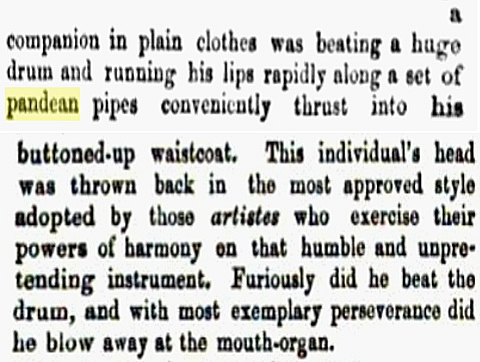 The Mysteries of the Court of London Volume 7 by George William MacArthur Reynolds · 1855 The Mysteries of the Court of London Volume 7 by George William MacArthur Reynolds · 1855 | ||
1865 1865 one-person-band with mouth-organ instead of the usual pandean pipes:
| ||
In 1880, advice about organising an event was given: “ First of all, in priority of engagement, is the musician. He must be able to play the drum - a tolerably easy achievement, in their style of performance, I should say - and the Pandean pipes, or mouth organ; a less easy thing to do.” | ||
.
| ||
| ** image examples here | ||
top of page
